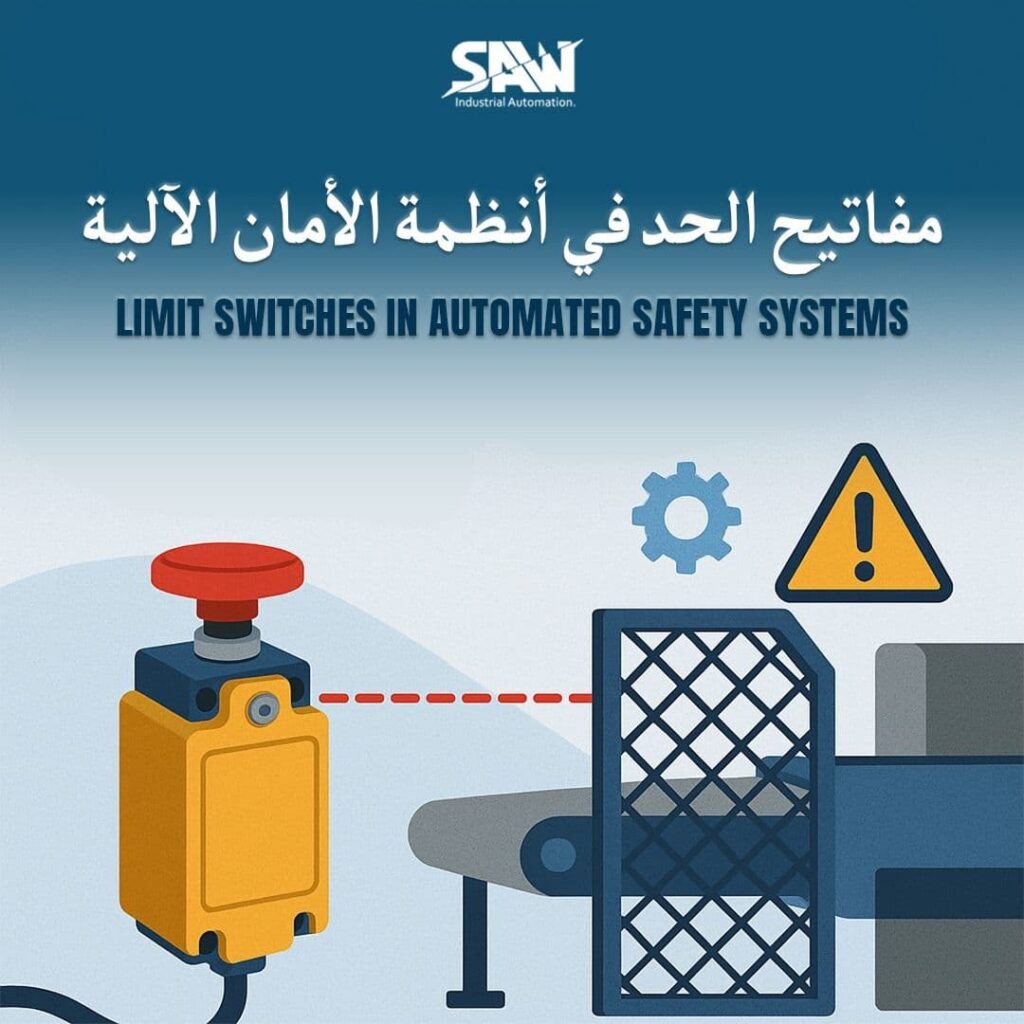The Role of Limit Switches in Automated Safety Systems

The Role of Limit Switches in Automated Safety Systems
Saw automation & electrical parts
Automation has become an essential part of industrial operations, especially in sectors such as manufacturing, oil and gas, packaging, and logistics. As processes become more complex and equipment speeds increase, safety has become a non-negotiable priority. This is where limit switches come in – a small but powerful component that protects people, equipment, and systems.
Let’s clarify why these switches are important, how they work, and why your automation system is incomplete without them.
What is a Limit Switch?
Simply put, a limit switch is a device that detects the movement or position of a machine part. It operates by closing or opening an electrical circuit when it comes into contact with a specific object, acting like a mechanical sensor.
Imagine a garage door stopping when it’s fully open or closed – this is the work of a limit switch. In factories, limit switches are used to determine the end of movement, detect overload, open doors, or locate moving parts.
Types of limit switches include:
Mechanical lever switches
Plunger switches
Rotary switches
Magnetic proximity switches
Each type is designed for different environments and applications depending on the nature of the machine.
Why are Limit Switches Important in Automated Safety Systems?
1. Preventing Equipment Damage
Automated systems often operate without human supervision. If a machine arm moves too far or a conveyor belt malfunctions, it can cause significant damage. Limit switches act as safety barriers, sending a signal to stop or reverse movement before damage occurs.
For example, in a hydraulic press, a limit switch ensures that the press doesn’t exceed its limit and damage the device or product.
2. Enhancing Operator Safety
The primary reason for using limit switches is safety. They ensure that moving parts stop before entering dangerous areas. Think of automatic gates, elevators, or robotic arms. If someone enters a danger zone while the machine is operating, the system must stop immediately.
Many systems are designed so that a door must be closed before operation. A limit switch on the door confirms this state, preventing accidents due to human error.
3. Ensuring Process Accuracy
Limit switches play a crucial role in maintaining accuracy. For instance, in CNC machines, limit switches determine the starting point. Without them, the system wouldn’t know where to begin, leading to errors and product damage.
They help maintain production consistency by verifying process stages, especially in packaging, assembly, and product sorting lines.
How Do Limit Switches Work in Safety Circuits?
Limit switches are typically connected to safety relays or programmable logic controllers (PLCs). They send immediate signals based on the position of the moving part.
A simplified example:
A machine part approaches its limit.
The actuator touches the limit switch.
The electrical circuit changes state (opens or closes).
The signal is sent to the control unit or relay.
The machine responds by stopping, alerting, or changing direction.
This sequence takes a fraction of a second, but it’s enough to prevent major accidents.
Some modern limit switches have dual contact points, so even if one fails, the other completes the function – crucial in critical systems like elevators and cranes.
Key Features to Look for in Industrial Limit Switches
Choosing the right switch isn’t just about appearance – you must select based on the application, environment, and safety level.
The most important specifications include:
1. Durability and IP Rating
Industrial machines are exposed to dust, moisture, and oils. Ensure the switch has a high IP rating, such as IP67, to withstand harsh conditions, especially in areas like Saudi Arabia where heat and dust levels are high.
2. Mechanical Strength
Since limit switches rely on contact, choose a model with a long mechanical life, especially in high-speed systems.
3. Switching Accuracy
In precise applications, activation must occur at the same point each time. Look for switches with high sensitivity and low tolerance for deviation.
4. Mounting Flexibility
Some machines require different mounting angles. Choose a switch that offers adjustable arms or flexible plungers.
Applications of Limit Switches in Safety-Critical Systems
1. Conveyor Belt Systems
Detect overtravel, belt misalignment, and prevent blockages. If a box falls or something gets stuck, the system stops until it’s fixed.
2. Elevators and Escalators
Monitor door positions, floor identification, and movement limits. The absence of switches can cause serious problems.
3. Packaging Machines
Ensure doors are closed, materials are loaded, and openings are aligned before starting operation – improving safety and production speed.
4. Oil and Gas Plants
In hazardous locations, explosion-proof limit switches are used to control valves and emergency shutdowns. These often come with safety certifications and reinforced housings.
Conclusion
Limit switches may be small, but their role in automated safety systems is significant. They protect equipment from damage, ensure worker safety, and increase process accuracy.
If you’re designing or developing an automated production line – whether in a packaging plant in Riyadh or an oil facility in Dhahran – don’t overlook the importance of limit switches. The right choice and proper installation enhance safety, reduce downtime, and improve operational efficiency.
.




